The 25 Most Influential Movie Scenes of the Past 25 Years
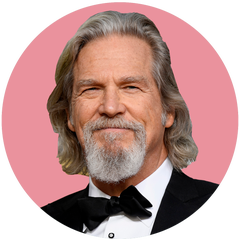


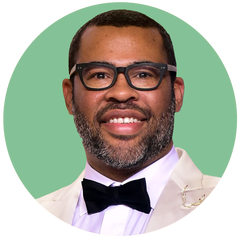

Sometimes, all it takes is a single scene to change moviemaking for good. (“Rosebud . . .” comes to mind.) And while many of the last quarter-century’s films have awed, inspired, and offered up iconic entries into the cultural canon, only some—and particularly, only a few individual moments—have genuinely influenced how future films were made. So, what makes that list? To mark the 25th edition of the Hollywood Issue, Vanity Fair’s film critics pinpointed 25 film scenes since 1995 that changed the industry, the art form, and even the culture, and our reporters spoke to the performers and filmmakers who made them happen.
A brief note from the editors on magazine math: Vanity Fair has published 25 Hollywood Issues beginning in 1995. In the spirit of our anniversary, we have taken that as our start date. Those decrying a lack of Pulp Fiction etc. on this list can get their Tarantino dose elsewhere in this year’s edition.
PlaytimeToy Story(1995)
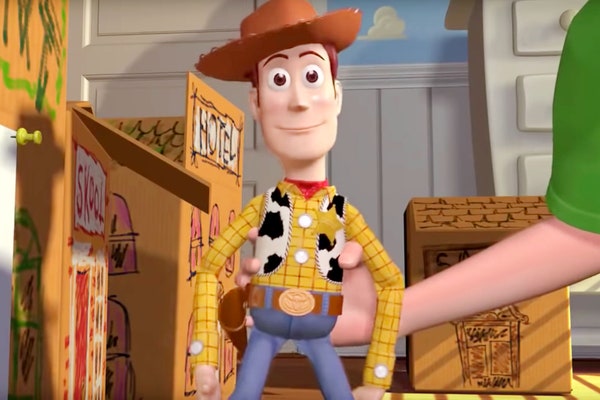
It’s all been there from the very beginning: the consummate genre cleverness, the animation with its affectedly rounded edges and warm tones, and the emotional appeals to not only kids but their nostalgic parents, who wish they were kids. All of this—what would come to be identified as the Pixar trademark—springs to life, fully formed, in the opening moments of the company’s 1995 debut film, Toy Story, as a boy named Andy plays cowboys with his delightfully mismatched toys: a cowpoke named Woody, Mr. Potato Head, and the rest.
So began the transformation of mainstream American animation, which, on the shoulders of Pixar, shifted dramatically toward computers and the rich, clever storytelling that has become as synonymous with Pixar as photocopies are to Xerox. It’s fascinating to watch this opening scene now, knowing what Pixar would become. Everything here—the Randy Newman needle drop, the adolescent delight—was a choice that would come to define a generation (and then some) of children and parents worldwide. —K. Austin Collins

“We had no idea what was going on. We didn’t know how many people to hire, how long it would take, but we dove in and blindly went forward. That’s the way to go, damn the torpedoes. In that sense, I look back at it fondly. From my standpoint, I was one of the grunts, I was not leading the charge. That was John Lasseter and Ralph Guggenheim who had to field all the trouble. For me it felt like an extension of school, a bunch of guys doing a fun project in their garage. It felt like something I would do even if they didn’t pay me. Like most things, you didn’t know at the time it was something to really value and pay attention to. My wife and I had just gotten married. I would work all day, come home and have dinner, and then she would come back to work with me and play video games while I animated late into the night.” —As told to Katey Rich
The Cold OpenScream(1996)
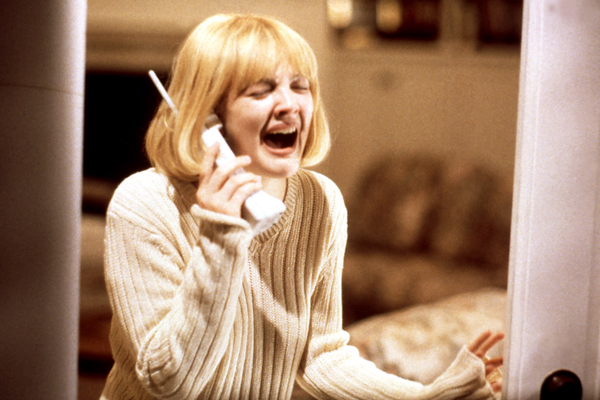
As the formidable teen boom of the late 1990s and early aughts was first churning into motion, along came director Wes Craven and writer Kevin Williamson’s zippy classic, all at once reverent and iconoclastic toward the slasher genre. No scene in the film was more indelible than Drew Barrymore—recently having reclaimed star status after some years in the wild—tangling with Ghostface the killer in the film’s shocking opening minutes. What that scene kicked off was a major cultural evolution, with teens being marketed to more and more as a disposable income-wielding consumer force, and a meta self-awareness seeping its way into every facet of filmed entertainment. The sly, scary wink of Scream’s actually pretty brutal cold open takes its fun seriously—and taught an entire generation how to talk about what they love. —Richard Lawson

“The script was so well written and the horror genre was sort of lost at that time. I remember everything like it was yesterday. Night after night of shoots at this house crying and hyperventilating. I loved that we turned things on its head a bit. I was originally supposed to play the Neve Campbell role and then I had this epiphany that if I played Casey and got killed in the first scene, all bets were off. Kevin’s writing had this tongue-in-cheek quality to it that felt different and fresh—a new approach to horror. I think when you do something that gets parodied not once but dozens of times, you definitely get the feeling it had an effect on people.” —As told to Joanna Robinson
“I’m King of the World”Titanic(1997)

It’s not so much that a bunch of movies after James Cameron’s seismic epic tried to copy its mix of sentiment and special effects—Pearl Harbor certainly did, but is that it? It’s more that Titanic opened the door for more maximalist thinking in Hollywood than had existed for a long time. Cameron pioneered the $200 million budget, and the extensive use of computer graphics in a film with no robots or trips to outer space. He made a true movie star for the ages in Leonardo DiCaprio, no more winningly or brazenly than with the triumphant launch of Titanic’s voyage. As the camera glides lovingly, freely around Cameron’s magnificent creation, he whips up a cinematic awe that’s so palpable it changed a medium’s conception of spectacle in an instant. Little that came in the years after quite matched that dizzy coronation, but a lot of people spent a lot of money trying. —R.L.

“When we shot this scene, it was cold and windy and awful down in Rosarito Beach. For the majority of it, we were outside. For the ‘King of the World’ scene, there was a separate piece of set—a tall tower-piece that just had the front of the ship. Leo and I would go on a construction lift and it would drop us off at the top, and then the lift would go away so that it wasn’t seen during filming. We were trapped on this little tower with our set coats so that we wouldn’t freeze. We were up there for hours because you would have to bring the lift back in, take it up, and then have us go down. So we were basically trapped up there. It was one of the most hysterical experiences. All I remember is we were very hungry. And at some point we both had to pee terribly and there’s no like, ‘Yeah, can we get the lift back in so that we can go to the restroom?’ There was none of that. We’re sitting there cold and hungry, and miserable, and having to pee. And on ‘action,’ it was supposed to be the most joyous experience in the world.” —As told to Laura Bradley
Gutterballs
The Big Lebowski(1998)
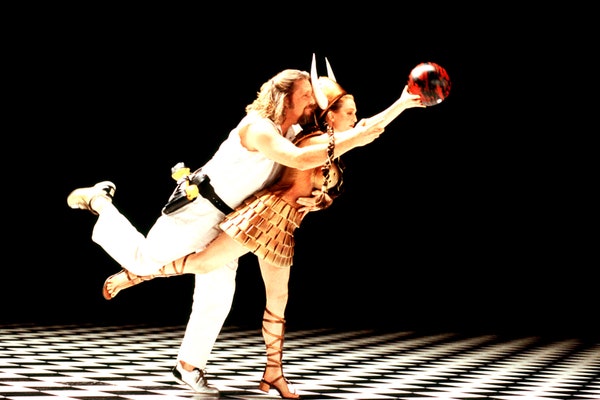
Since at least the New Hollywood era, our favorite American auteurs have been filling their movies with references to other classic Hollywood movies. They’ve been showing off just how much the history of Hollywood fills their DNA; directors, their public image says, are movie-lovers above all else. And yet even by those standards, it’s funny to see a modern, American cult-film nod, not to Howard Hawks or old gangster movies or the like, but to the dizzying, kaleidoscopic dance numbers of Busby Berkeley, known for filling the screen with circles and rows of showgirls, dancing out geometric fantasies to the audience’s delight.
The Big Lebowski is one such movie, and its famous “Gutterballs” fantasy sequence, with its dancing bowler girls, flying Jeff Bridges, and Viking Julianne Moore, is one such scene. Lebowski is a simmeringly smart—but also wild—tale, anchored by a loose, meandering central turn by Jeff Bridges as the Dude, who finds himself caught up in a world of mistaken identity, nihilist thugs, bowling, extortion, and outrageous violence. Not that the plot is what matters. The Big Lebowski is about a world, a political landscape, in which conflicting American values clash against each other, all of it embedded in style, references, and stoner dreaminess. It’s the ultimate American movie, a feature with underground cultural credibility that is also an icon of independent moviemaking and bro-cinephile obsession. —K.A.C.

“I had a little concern about how it was going to be directed by two people. I love my brother, but I think it would be really challenging to direct a film with him. I was wondering how it was gonna be to be directed by these brothers, and the only time that there was any disagreement between them was in that scene. It was just about when I was gonna hit my head with those bowling pins, and Joel said, ‘Now, when you’re gonna hit the bowling pins, kind of wince a little bit, ’cause you’re gonna be expecting some kind of pain.’ And Ethan says, ‘No, really—you think so? I think he should be kind of smiling, like this is kind of fun to be a bowling ball.’ Joel said, ‘You really think so?’ And it kind of went back and forth like that then finally they just said, ‘Well, let’s shoot it both ways.’ That was the big disagreement.” —As told to Mike Hogan
The Storming of Omaha BeachSaving Private Ryan(1998)
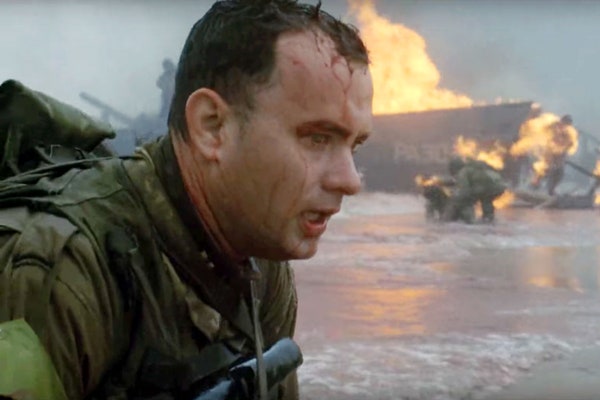
The inventor of the modern blockbuster had already proven himself a Serious Director with The Color Purple and Schindler’s List, the latter redefining Spielberg’s aesthetic range in startling fashion. But with the opening salvo of his 1998 war masterpiece, Spielberg not only pushed his own art forward—he changed an entire genre. No films about combat made since would look the way they do without the de-saturated, handheld, blood-splatters-and-all horror of cinema that is this extended sequence: Spielberg and his trusty cinematographer, Janusz Kaminski, following a terrible march up a beach, bullets and mortars raining down, sand exploding into carnage. It’s a terrifying scene, either honorable or exploitative in its all vérité, depending on whom you ask. Regardless of any moral assessment, it’s easily one of the most aped and referenced scenes of the late 20th century, inspiring countless other action and war movies, and video games. —R.L.

“In our very first talk about the movie, Steven laid out how modern cinema technology made the movie possible in the first place—especially for the Omaha Beach sequence. He said no combat movie would have ever been like it. I knew immediately that our job as actors would be to behave and react in the actual physical moment, that we would be trained accordingly over time, and that anything that happened on-screen would be as it should. My rank as captain mattered in training. I had some responsibility and some luxury (my own tent!)—but on the set, the script played itself out. We all had our moments in the movie and rooted for each other. When I first saw the completed sequence, I wept. The landing, from the boats to the top of the bluff, was just too horrible to watch without becoming undone. People see that landing sequence as a seminal 20 minutes, not just in the history of war movies, but in all of cinema.” —As told to Katey Rich
Dodging Bullets The Matrix(1999)
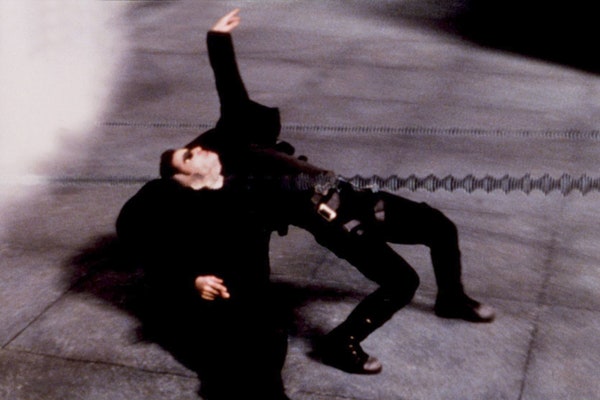
It was hard for us to pinpoint which exact moment in the Wachowskis’ seminal sci-fi actioner changed filmmaking forever. Was it the opening scene, with Trinity (Carrie-Anne Moss) battling policemen using a wicked floating kick? Was it hacker-hero Neo (Keanu Reeves) sparring with his mentor, Morpheus (Laurence Fishburne)? Was it the hallway gun battle? Any of those would have been valid choices, but the sequence in which Neo dodges bullets on the roof, and Trinity does a kicky “dodge this” while slo-mo shooting a bad guy, contains the most representations of The Matrix’s technical and stylistic flair, which directly shaped 21st-century film. The Wachowskis gave so much to the current action-movie vernacular, seen in 300 and Wonder Woman and countless other projects that have made the awed Keanu in all of us say “Whoa.” —R.L.

“When it came to shooting Neo dodging the bullets, it was on a stage with a green screen and more than 100 cameras. I was on a wire, and it was extraordinary to be the human piece of ‘bullet time’ and do something physically impossible. I threw myself back, did the choreography—everyone was really excited hearing the camera shutters. Then, of course, in Wachowski fashion, we did it a whole bunch more, looking for super-perfect. Then, we started to see ‘bullet time’ enter the mainstream in commercials, and the Wachowskis became a part of our visual language. You see them moving a camera like that now during football games. There’s nothing like the original, but it’s still always cool.” —As told to Joanna Robinson
Heather’s MonologueThe Blair Witch Project(1999)
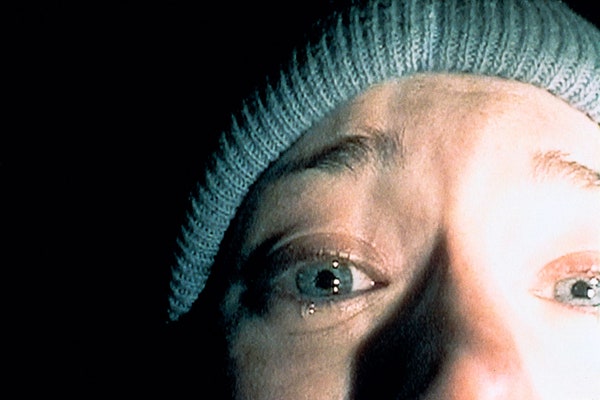
All it took was a brief, close-up glimpse of half of actress Heather Donahue’s panicked face—teary and dripping—to get America interested in The Blair Witch Project. Arguably the first film largely marketed on the Internet, this tiny indie-horror film-turned-box office smash and cultural bellwether arrived at the end of the last millennium as a harbinger of things to come. The film’s successful experiment in Internet virality hinged on that footage of Donahue, supposedly a real-life filmmaker who’d gone missing in the Maryland woods, being so visceral and credible. A strange and immediate publicity tool, Heather’s close-up and its deft deployment laid the groundwork for many a future Internet campaign, and gave the found-footage horror genre (perhaps perfected by Blumhouse) more prominence than it ever had in, say, the Cannibal Holocaust days. Heather might have gotten her friends (and herself) killed by a witch, but she made a lasting contribution to the rest of the world. —R.L.

“We needed a moment somewhere at the beginning top of the third act, where Heather finally comes to terms with what’s happening—and also takes some responsibility for what she’s done. We told Heather, ‘This is the deal: you’ve finally hit a wall and you need a sort of confessional now where you realize you may not get out of this, and you need to leave some kind of last will for your parents and your friends, and apologize.” We just laid that kind of emotional groundwork for her and let her improvise. It went on for, I don’t know, almost 15 minutes; we cut it down to just a few—the best moments. Once we saw the performance, we knew we had it. She ramped up into it, as you would expect—after she sort of got into the moment and really let it flow, both with her tears and her snot, which was profuse. Those are legit tears.” —As told to Laura Bradley
“Hip to Be Square”American Psycho(2000)
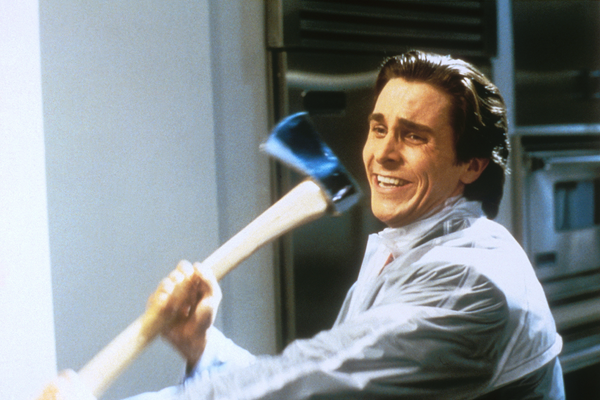
There’s just something about Patrick Bateman. Antiheroes are most certainly not a 21st—or even 20th—century innovation. And the history of American movies, specifically, has been full of them, from the down-and-dirty gangsters of the 30s (in real life and the movies) to Clint Eastwood’s mysterious outlier, The Man with No Name, whose silence had the strange effect of tearing Western myths apart.
And yet neither of those archetypes comes anywhere near to explaining the Bret Easton Ellis invention Bateman, who, as chaotically brought to life by Christian Bale in Mary Harron’s darkly satirical American Psycho, isn’t just an antihero—because he’s a rich yuppie who terrorizes and brutally murders women and the homeless. He’s an antihero because he’s such a dick about it—and yet so addictively watchable! No scene better sums up his inexplicably vibrant, outrageous charm than Bateman murdering a colleague while discoursing on the canonical status of the Huey Lewis and the News banger “Hip to Be Square.” And no scene’s popularity is a better testament to our strangely capitalistic affection for bad men—the kind of cultural error Bateman himself would have railed us for. Arch cultural references became the American pop ethos as of this movie—to say nothing of Bale, a chameleonic force we would be watching for years. —K.A.C.

“I felt the audience could handle this scene being quite comic. Usually, we kept the lighting in the apartment moody—but when it came to filming this scene, I insisted we have all the lights on bright. I wanted it to be harsh and jarring; I was also thinking Kubrick, A Clockwork Orange. In the very last take, there was one of those lucky accidents that make filming worthwhile: Bateman had just finished killing Paul Allen in a frenzy, and he sits down on the couch and lights a cigar. As he did so, I saw that the blood had only spattered one-half of Christian’s face. In profile, he looked almost normal—but when you cut to another angle, you saw the bloody side. When it came out, the movie was loved and hated in about equal measure. It was only after a few years that its reputation grew in a way I can’t explain. I think the mixture of black comedy and horror and satire was unfamiliar and uncomfortable, and maybe that very nightmarish portrait of society and Wall Street felt more relevant as time went on.” —As told to Hillary Busis
The Night FightCrouching Tiger, Hidden Dragon(2000)
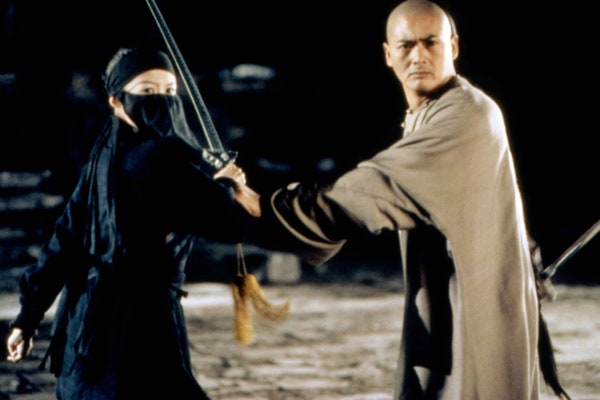
When Crazy Rich Asians reached theaters in 2018, it was hailed as a breakthrough for Asian filmmakers and stars in Hollywood—really, though, it was the second one, too long delayed toward progress that had been initiated almost two decades before, by Ang Lee’s Oscar-winning worldwide hit, Crouching Tiger, Hidden Dragon. The film, produced in China, starring the internationally known Hong Kong action star Chow Yun-fat, and directed by the Taiwanese (and by then widely known in the West) Lee, was an old-fashioned wuxia epic, full of the high-flying martial arts that verge on surrealistic fantasy. Crouching Tiger remains unique for ushering in not only broader Western awareness of this time-honored Hong Kong movie genre, but particularly a mainstream American interest in foreign-language cinema. One that was even bigger than the foreign art-house boom that took American cinemas by storm in the mid-20th century.
Even in 2018, even given the steeply increased role of Chinese financing in Hollywood, it’s hard to imagine a lush martial-arts melodrama set amid the 19th-century Qing dynasty—and entirely performed in Mandarin, no less—becoming a domestic blockbuster. Any one part of that equation would be a nonstarter for the local megaplex. Yet this consummately produced, gorgeous first-act fight explains exactly how Crouching Tiger came to be such a success. Lee’s filmmaking floated and tumbled with the ease of his actors. It’s brought to life in the brief but memorable role for the wuxia great Cheng Pei-pei, who plays the antagonistic star of this scene. Her presence alone is moving, a humbling testament to the merging of East and West that this film would come to embody. —K.A.C.

“Crouching Tiger is the opposite [of Brokeback]. I planned everything; everything worked against me. Even the weather. A lot of it was shot in the desert, it was really tough. There’s nothing. At that time, 1999, making that kind of scale of movie in China—it’s like a handcrafted space shuttle. That’s how it feels. The movie industry was not like today. People are not trained. To start something new, that was ambitious work. Crouching Tiger was meant to be a mainstream Chinese movie, but it hit so big here, even bigger than over there. That was unexpected. Every movie has its fate: sometimes it hits, sometimes you hit the wrong time. I’ve tasted both [laughs]. That one just took off.” —As told to Yohana Desta
“King Kong Ain’t Got Shit on Me”Training Day(2001)
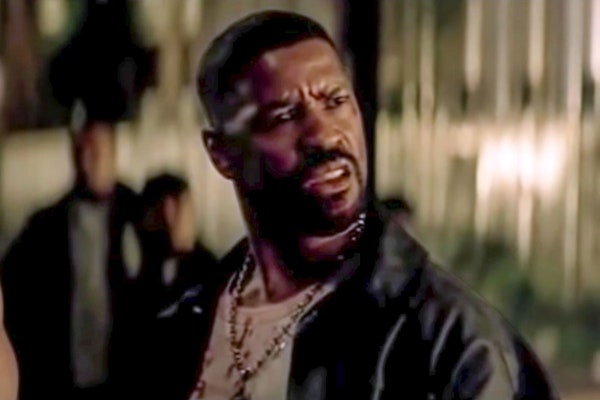
With his famous, furious rant as corrupt L.A. police detective Alonzo Harris, Denzel Washington launched a new stage of his career. He won his first Oscar for best actor in a leading role, and began a lucrative partnership with director Antoine Fuqua. The two have gone on to make three more box-office successes together, and Washington asserted himself as quite possibly the last truly bankable movie star in the business (before The Rock came along, at least) with only minimal assists from any franchises. Putting one big moment for one actor on this list may seem like a bit of hyperbole. But Washington’s career—as both action-thriller hero and awards-worthy thespian—has been vital to Hollywood’s economy and its understanding of itself over these charged and changing years. Washington was also the first black man to win the best-actor Oscar since Sidney Poitier. That same evening, Halle Berry became the first black woman to win a best-actress Oscar. Those victories marked the hopeful beginnings of the long, tortured process of the Academy—and the broader industry—addressing its longstanding and widespread diversity issues. —R.L.

“The King Kong moment came out of Denzel. I remember that moment because we were doing the scene, and he just started going off. I remember looking at the cameraman and saying, ‘I hope you got that, because I don’t think we’re going to get that again.’ Denzel came over to me and goes, ‘Whoo, I don’t know where that came from.’ It was exhausting for him, you saw him just go there in that place. It was one of those moments where it gave you chills. We shot anamorphic lenses, so anamorphic lenses are really sensitive to making sure everything’s in focus. My focus puller came up to me afterwards, his hands were shaking. I started hearing it referenced a lot in rap songs, a lot of rappers saying stuff about Alonzo, or Training Day, or “King Kong ain’t got nothing on me,” or “this is chess, not checkers.” The moment I realized it took on a different life was with Ethan Hawke. Ethan was in Harlem doing something one day and he called me and said, ‘Wow, I’ve got a whole new audience, all these people came up to me.‘ You just set out to make a good movie and somehow it became a cultural thing.” —As told to Katey Rich
Enter MargotThe Royal Tenenbaums(2001)
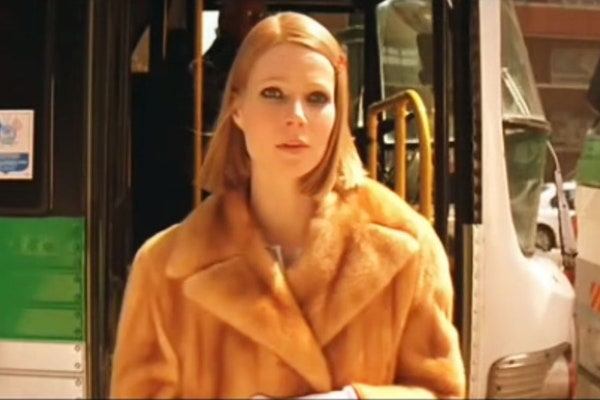
Wes Anderson’s films are full of moments that have been mimicked and borrowed from over the last 20 or so years. Maybe the best distillation of that cherished style is Gwyneth Paltrow’s lovely slow-motion walk from a bus, Nico’s melancholy “These Days” playing as Margot Tenenbaum approaches her one true love. Beyond all of Anderson’s mannered kitsch, this is the kind of thing that has clearly resonated for so many filmmakers since, a kind of artful, playful wistfulness, stylish and deceptively simple, and scored with just the right unexpected song. Anderson’s arch, presentational style is a bit harder to ape without outright copycatting, but the sentiment he brings to some of his films, somehow both crisp and bleary, has been mirrored in immediate descendants like Little Miss Sunshine, Juno, and Garden State, and its longer influence lingers in films like Lady Bird, in glossy television series like Transparent, and in numerous TV commercials and music videos. —R.L.
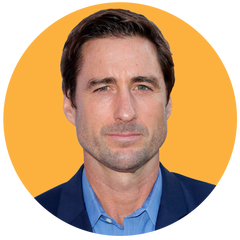
“That probably would have been one of six or seven things that we shot that day. It just would have said, ‘Margot exits bus, Richie waits for her.’ But then that’s where you see Wes’s qualities, where you slow it down to 16 frames per second and then the great expression that Gwyneth has on her face. You get magic moments like the wind in her hair, and it’s slowed down, and you have Nico singing that beautiful Jackson Browne song. I can remember going to see The Doors with Owen and Wes in Austin, when it had first come out, and there was kind of the cool sequence where the Velvet Underground song “Heroin” was playing through this sequence of Jim Morrison being out of control. Those guys both kind of clenched up because they’d wanted to use the song “Heroin” in something. I’m just sitting there thinking, ‘God this is an incredible movie, what a scene, what a song,’ and they were both like, ‘Dammit, now we can’t use this song.’ These guys haven’t made a movie yet, but you get the feeling they’re in competition with Oliver Stone.” —As told to Katey Rich
Moore vs. HestonBowling for Columbine(2002)
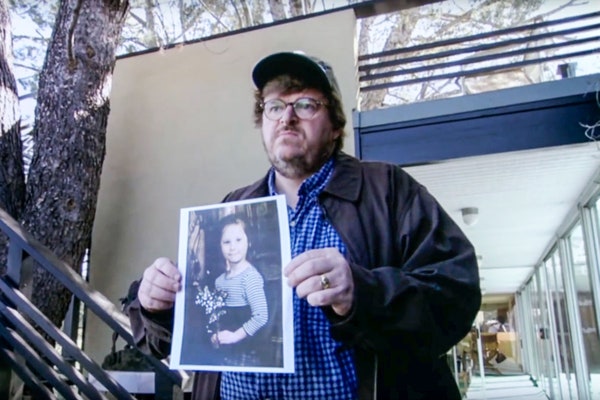
You frankly cannot imagine Hollywood's modern political image without Michael Moore—and not only because of the steady stream of homegrown, outspoken political documentarians to follow in his stead (including Steve Bannon). Few American filmmakers have seemed as consistently on topic, off their rocker, and simply around as Michael Moore. And Bowling for Columbine, his 2002 testament to a growing national fear over mass gun violence, forged in our collective fury over the Columbine High School massacre, is probably the greatest evidence of that. Here it is, 2019, and we’re still talking about guns.
It’s a film overstuffed with memorable moments that would leak out into the broader culture: a South Park–esque animated history of the Second Amendment, a chillingly insightful interview with Marilyn Manson that teases apart just how this outsider came to be a national scapegoat, and so on. But nothing sums up Moore’s mosquito-like knack for annoyance or his delight at the well-timed ambush more vividly than his off-the-walls closing interview with Hollywood great Charlton Heston—a Rosetta stone moment for the next two decades of national debate, online and in public, between celebrities, civilians, liberals, and conservatives, over gun violence. —K.A.C.

“I’m uncomfortable watching the scene now, and I’m uncomfortable sitting there with him. But I wasn’t going to not put it in the film either. He revealed his core beliefs. But I remember feeling kind of sad about it later. Here’s a man who 40 years prior to that marched with Martin Luther King, and now in his elderly years had just turned into this angry white guy who believed that we should have these laws where it’s O.K. to shoot first and ask questions later. When the film came out, the N.R.A. was furious and they spent a lot of money, I think, on surrogates, putting them on newscasts, trying to attack me and attack the film. When they did that, it went on to break the record at the time for box office. When we started making that film there had not been a school shooting like Columbine. We thought, we need to make this film so this doesn’t become a thing. Now mass shootings are almost a daily occurrence. Our mission, I guess, failed.” —As told to Katey Rich
Gollum vs. SméagolThe Lord of the Rings: The Two Towers(2002)
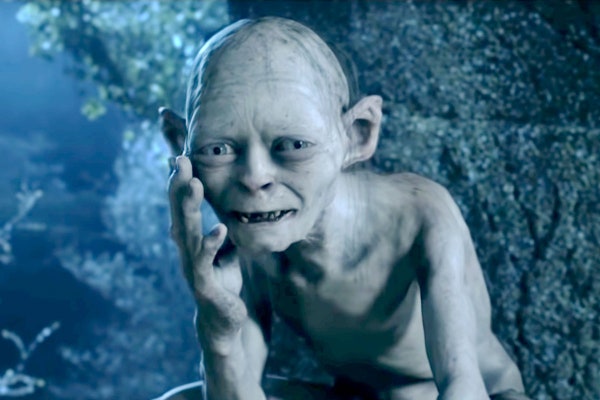
Any actor fretting about the encroaching development of real-time motion-capture technology, which might someday make live acting a thing of the past, can look to the brilliant Andy Serkis for blame. Beginning in 2000, Serkis teamed up with director Peter Jackson and Jackson’s FX wonder-house, Weta Workshop, to do something unprecedented. As the tortured cave creature known as Gollum—once a Stoor Hobbit named Sméagol, since ruined by a magic ring—Serkis acts against himself, staging a fraught debate between loyalty and murder that is the thrilling highlight of an already plenty-exciting movie. Funny, creepy, and dazzling, the scene helped convince the rest of the industry that not only could motion capture and other digital performance be viable on a technical level, but that, done in real time on set, it could capture a depth of feeling that’s of crucial emotional value to a film. Whether you love or loathe what this scene spelled for the art form in the years that followed, this lonely aria is a thing of true, lasting power. —R.L.

“We began to evolve this whole notion of Sméagol and Gollum being two very different personalities, one of which was the visceral controlling Gollum, but then this schizophrenic feeling toward Frodo and then the power of the ring was manifested by the Sméagol side, who became the younger brother that is manipulated and abused by the elder, brutal kind of sibling. And obviously that came into being fully in that scene. I knew it was a really important scene, you just have the feeling. At the world premiere at the Ziegfeld here in New York in 2002, I just remember when it came to that scene I literally felt the audience all as one lean forward in their seats. As an actor, I’ve never experienced anything like that, or hadn’t at that point. You could hear a pin drop, you could also hear people not kind of understanding— is this an actor, is it a real person? It felt kind of emotionally real and present. It was really gratifying.” —As told to Katey Rich
Famous Last WordsLost in Translation(2003)
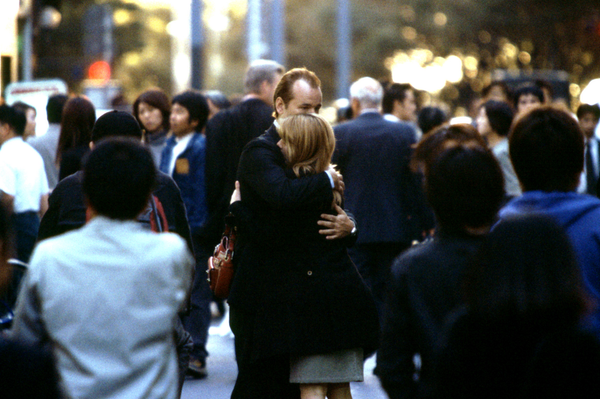
The curiosity of Sofia Coppola’s Lost in Translation is that it wafts into view sure of itself, aware of its heroine’s annoying privileges and poised to see them, not with ridicule, but with curious sympathy. It’s the kind of film that can’t help but feel autobiographical—in the way that every Coppola feature has to date, to some degree. And nothing in Coppola’s work feels more immediately personal than her style: soft and sharp at once, good-humored, modern, soul-baring. It revived Bill Murray’s career with the kind of pitch-perfect immediacy that hadn’t been seen since John Travolta in Pulp Fiction. And it made a star of the smartly sensuous Scarlett Johansson, who carries this featherweight movie on her shoulders with an invisible grace.
Had it occurred to young romantics in 2003 that romances needn’t be romances, per se, bogged down with all the tension of sex and emotion, before Lost in Translation? Had any other movie so aptly proven that dramas could end as mysteries, or that self-awareness needn’t be tamped down with self-ridicule? A million indies were born of the dreamy tone of Coppola’s film, and its ambiguous ending—then so surprising—has been aped in various forms again and again. —K.A.C.

“I’m pretty sure it was our last day of shooting. We were exhausted, so I think it helped that they really were saying goodbye. I didn’t intend [the end] to be a big thing. He whispered something between them. It came from the tradition of Italian movies—they would just say numbers and figure out the dialogue later. [But] then we left it. We never seemed to be able to sum it up. I always liked that Bill Murray says it’s between the two of them. [Everybody] asks what he whispers to her. I just don’t get why it’s such a thing, but I’m touched that people feel connected to it. I hadn’t seen it for a long time, but I watched it last spring, because we went to Japan on a family trip. We were staying at the Park Hyatt, so I wanted to show [my daughters] the movie. Watching with 8 and 11-year-old girls really changed the way I looked at it. Like, what’s the shot of [Scarlett] in her underwear? [Bill’s] so much older than her. My daughters are raised in such a different generation. When it’s on TV, sometimes I’ll stop and watch it for 15 minutes or something. It’s like an old photo album. It’s fun when it pops up, but I don’t sit down and review my work. I go on and don’t really look back.” —As told to Yohana Desta
Erica Writes a PlaySomething’s Gotta Give(2003)
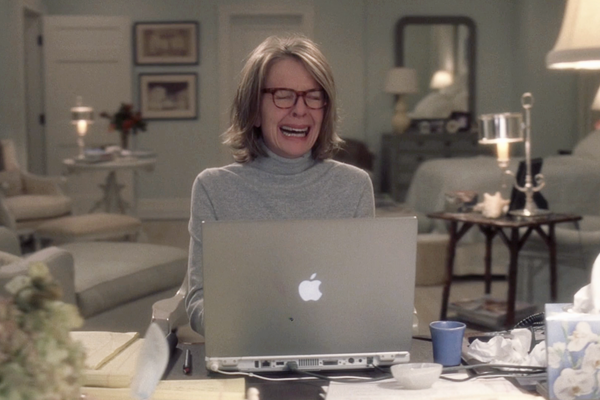
The story for a while has been that rom-coms are dead, but that isn’t quite true: they’ve simply transformed—into a genre whose virtues are now typically found in films tailored to older women. No filmmaker is more responsible for this than Nancy Meyers, who in 2003 released the Diane Keaton and Jack Nicholson hit Something’s Gotta Give, in which a successful playwright (played by Keaton) falls for her daughter’s new boyfriend—who happens to be closer to her own age.
In the silliest, most contagiously funny scene in Something’s Gotta Give, they’ve broken up, and Keaton, leaning in to the fanciful delight of the genre, pulls an all-nighter writing their romance into a new play. It’s memorable for the whole movie being in on the joke, enwrapping Keaton in a whirlwind of tears, as well as for Keaton herself, a veritable hurricane of melodramatic hilarity. From the start, this is a movie with one foot in the door of rom-com serendipity, and another in the unlikelihood of its lead characters being people in their fifties and sixties. And yet, per her style, Meyers dials up the youthful fantasy of the rom-com, allowing not only for the possibility of older romance, but for the possibility of an audience for such romances. —K.A.C.

“The scene really came more from my life and a relationship that ended that I had, and that was kind of what I was like. I wrote Something’s Gotta Give like that. It wasn’t quite that extreme, but I am supposed to dramatize things. The scene is funny because it never ends. Because of the length of the montage, it’s not just, ‘I’m sitting on my bed with way too many Kleenex’; it’s, ‘Something happened to me that just changed me.’ Throughout the movie up to that point, she’s unclear what her new play is about. This gives her everything to write about. Having that kind of purpose got her through this. Honestly, there’s nobody that could have done it but Diane Keaton. She managed to make you feel the pain she was feeling, and she also made you laugh, within a second of each other.” —As told to Katey Rich
“The Chosen One”Star Wars: Episode III—Revenge of the Sith(2005)
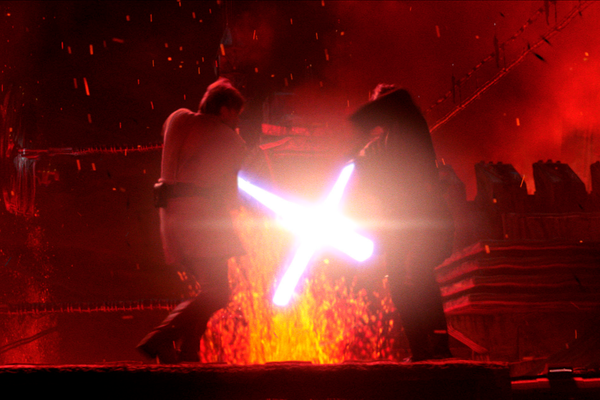
Not all the films on this list have influenced Hollywood in a positive way. Take the third of George Lucas’s seriously misguided Star Wars prequels, which contains the climactic scene in which a young Obi-Wan Kenobi (Ewan McGregor) confronts and permanently maims his onetime protégé Anakin Skywalker (Hayden Christensen), pushing that wayward Jedi even closer toward becoming Darth Vader. Finally, the circle was completing; this grand space-opera tragedy was getting its full realization. But the scene arrived at the end of so much disappointment, a creative nadir that, even more disappointingly, inspired imitators instead of scaring them off. All of Lucas’s aggressive blue/green-screen technique became frustratingly de rigueur for big-budget spectaculars, even though that cold C.G.I. gleam was something that turned many people off from the franchise. Seven years after Revenge of the Sith’s release, Disney acquired Lucasfilm, and thus the Star Wars universe, setting about course-correcting the film series. That led to 2015’s The Force Awakens, which grossed over $2 billion worldwide. Which isn’t to say that Lucas’s prequels weren’t financially successful in their own right. They absolutely were—fan-loathed messes that nevertheless introduced a new malleability to time and continuity’s function in franchise filmmaking—a creative license that studios take more and more each sequelizing and prequelizing year. —R.L.

“Episode III was all green screen: they had us on green disks on a green floor with a green background, and a guy on the floor rotating us like chickens, as we lunged at each other with lightsabers. What keeps you emotionally grounded is the other actor. Episode II, I was on my own, speaking to thin air. But this scene was harrowing for Obi-Wan. I lose Anakin, and we see the danger of what it might lead to in Episodes IV, V, and VI. For all my moaning about green screen, I did enjoy playing Obi-Wan and this link to Alec Guinness. George Lucas wanted to do something very different with the prequels. That’s why people felt cheated. It was upsetting when people would laugh and joke about it. Now, many years later, the prequels meant a lot to the generation that were kids then. So from smirking, cynical opinions, now I’m getting feedback from the kids they were made for. I’m really happy about that.” —As told to Joanna Robinson
The Chest WaxThe 40-Year-Old Virgin(2005)
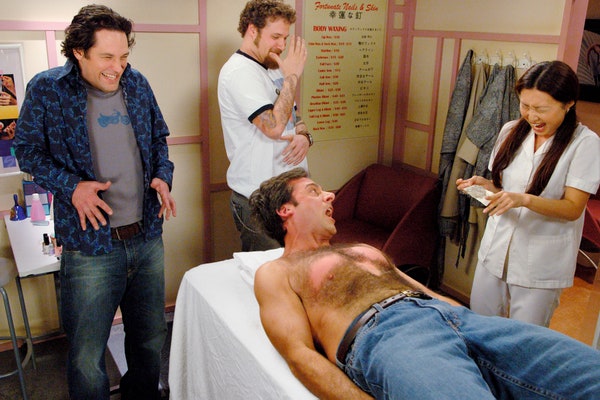
With one “Oh, Kelly Clarkson!” used in every trailer and TV ad, Judd Apatow’s rambly, improv-y style of comedy—full of unexpected pop-culture references like Steve Carell’s immortal chest-waxing exclamation—entered the mainstream in full. That easygoing, friends-shooting-the-shit vibe, peppered with bits of manic high-comedy, would become the standard for the next decade-plus. A zillion films have tapped into that same discursive energy, Apatow’s repertory company all spinning off to do their own things, from superhero movies to Sundance successes. The Apatovian comedy has faded a bit in its primacy in the last year or two, making way for an alt-er, queerer style burbling up out of Twitter and the remnants of mumblecore. But The 40-Year-Old Virgin’s stamp remains significant, a bright and pained declaration of amiable, silly good times. That it was mostly the boys who got to enjoy those good times is maybe part of the reason they now seem to be fading. —R.L.

“Steve said, ‘Just shoot me actually getting my chest waxed, because I’m very hairy, and I’m sure it would hurt. And it would be funny to see me in pain.’ So we hired an actress who claimed to be a professional chest-waxer. When we shot the scene, it seemed pretty clear that she’d lied on her résumé. Steve almost lost one of his two nipples. He was bleeding—we had to use C.G.I. technology to remove most of the blood, because it was too troubling to look at. Paul [Rudd] was the one who noticed that it was turning into a shape that looked like a Halloween pumpkin. And then as soon as we noticed that he was looking like a man-o’-lantern, we made a point of telling the waxer to continue in that configuration. It was really funny, and it’s all because of how Steve reacts. He’s actually in intense pain, but he completely stays in character, doing jokes while basically being tortured.” —As told to Hillary Busis
“I Wish I Knew How to Quit You”Brokeback Mountain(2005)
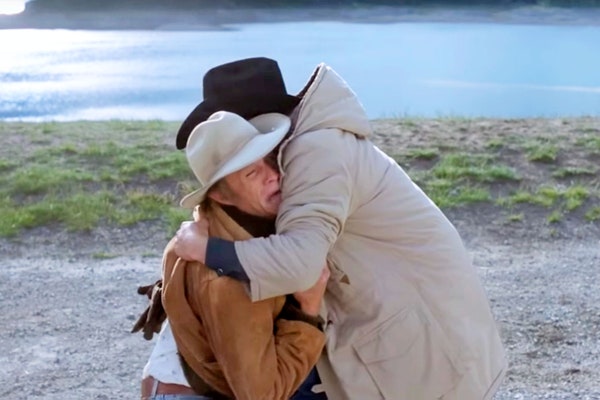
There were queer films before Brokeback Mountain—there have been queer films since the silent era. But Ang Lee’s 2005 drama, adapted from Annie Proulx’s somber, lyrical short story of the same name, was a significant step forward in the winding, fraught history of queer life in the mainstream. The film starred Jake Gyllenhaal and the late Heath Ledger as a pair of quiet, guarded, temperamental cowboys in love; straight actors in what has otherwise—given the soaring, masculine landscape and all the Western trappings—tended to be a straight genre. Queerness had reached Hollywood in a big way: its own classical codes of manhood and romance were being re-written before our eyes.
Though not, perhaps, without a price. At the emotional climax of the movie comes the line, shouted mid-argument, that quickly became a source of parody: “I wish I knew how to quit you.” Earnest but impossible romance tends to have that effect on people, and the line sums up the film’s predicament handsomely. Whereas at first these men’s romance was obscured by the furtiveness of secrets and time stolen away, here was their affection being announced out loud, in the open, with nature bearing witness. It’s part of a one-two gut punch that includes the film’s tragic ending, all of it very canny. Here, to be sure, was a sign of Hollywood’s progress in action. And here, as well, was a testament to its limits. —K.A.C.

“That scene was actually [shot] in a reservoir, in a small parking place. It has the best view of this Canadian mountain. There was snow, there was water—it was perfect. I remember building up to that [scene], I did something weird with the camera, kept moving it, to freak [Ledger and Gyllenhaal] out a little bit. Keep them fresh. It was a rough shoot for the actors, I would say. Heath was very intense; he didn’t want a lot of distraction. He was just very specific about the goal he wants to hit. Jake, on the other side, he was very young, at times naughty, experimental. That would drive Heath crazy sometimes . . . [but] in one take, Jake hit it. That speech came from one take. It was beautiful, but they didn’t believe me. Actors, they’re all skeptical. The reason I wanted to do the movie is that one line: ‘All we have is Brokeback.’ It’s not even that line [‘I wish I knew how to quit you’]. I questioned that line in the script. ‘Is that too much?’ Everybody picked that line up. None of us expected it.” —As told to Yohana Desta
The AmbushChildren of Men(2006)
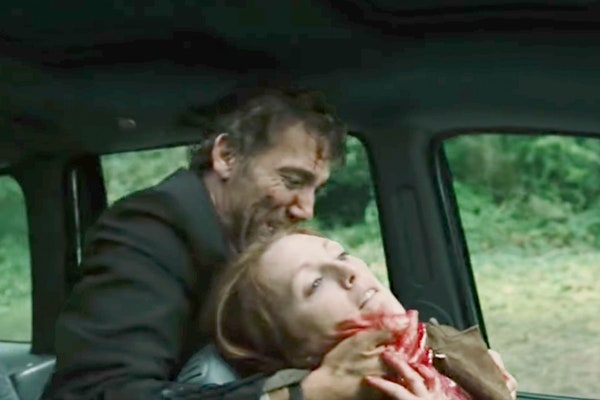
The impressively choreographed long takes that have overtaken mainstream movies seem mostly to have one of two major influences: Martin Scorsese’s free-flowing introduction to the inner workings of the Copacabana in Goodfellas, and Alfonso Cuarón’s Children of Men—which features a handful of such impressive shots, including its six-and-a-half-minute-long climax shot in which Clive Owen tumbles through a fearsome battle. But it’s an earlier sequence, in which Owen, Julianne Moore, and their fellow travelers are ambushed on an idyllic Canterbury road, that establishes the frantic, anxiety-producing potential of the form. It’s the kind of shot we now see again and again, parodied and not, in films as technically accomplished as Alejandro González Iñárritu’s The Revenant and HBO’s True Detective. It set a standard for showing off.
Children of Men, released in 2006, set a new high bar for science-fiction filmmaking, which is saying something for a genre that, thanks to the likes of Steven Spielberg, James Cameron, and George Lucas (to say nothing of Stanley Kubrick), is constantly breaking the mold of blockbuster filmmaking. Cuarón’s was a project for a new era—grittier, for one thing, as well as a deft combination of entertainment and ideas, action and mythology. The long take is its loudest accomplishment. —K.A.C.

“Obviously, everybody thought we should do [it] in C.G. And for a couple of months, we were all satisfied with the main idea. But every time I thought about it, something felt really weird and wrong. Something told me that shooting that scene in green scene was going against everything else that we’d done. By doing tests, I realized that if I was able to hang the camera from the roof of the car, maybe I could do the entire shot in one shot. That was important, because it’s a way of immersing the audience—and also not glamorizing violence. By doing everything in real time, I think you feel the desperation and the claustrophobia of the characters. It’s a very long story, but I found all these pieces that were made for other things. I came back to Los Angeles, and we put together this thing that’s called the H dolly on top of a car. And in only one week, we put together this thing that nobody has ever done before.” —As told to Krista Smith
“I Drink Your Milkshake”There Will Be Blood(2007)

By 2007, with the likes of Boogie Nights, Punch-Drunk Love, and the manically ambitious Magnolia already under his belt, Paul Thomas Anderson had more or less fulfilled his promise as a standard-bearer for the next generation of Serious American Moviemaking. And then came There Will Be Blood—and with it, the searing-hot Daniel Plainview, instantly one of the most unforgettable characters in the history of American movies.
You can read the hot-tempered, damnedly secular, unforgiving oil tycoon as America’s will incarnate, with all its mangled, festering vices and virtues summed up in Plainview’s overdetermined mustache and devilish glare. But Daniel Day-Lewis, who brings him to life, makes it impossible to see him solely as symbol or abstraction. This is a film about a performance—a movie that gets bigger, wilder, as the man at its center does. In the movie’s brutal final moments, Plainview, dilapidated with corruption, jumps the rails of his sanity and delivers a coup de grâce of an ending that remains unusually bold for American filmmaking. “I drink your milkshake,” he says, relishing the deviance of his business plan—just before beating America, the spiritual symbol, to death. It’s an earth-shattering high point in both the actor’s and director’s careers—big acting and big auteurism for a generation of movies that was beginning to forget them. —K.A.C.

“We didn’t have a really good ending. Paul had written a few different scenes; very early in the scripting, there was a reporter coming to talk to Daniel at his mansion, and that didn’t fly. The end of the movie just didn’t seem to have a point. Once the part of Eli Sunday was re-cast and it became Paul Dano, it turned into a totally different character. The milkshake line—I think everyone cocked their head and laughed when they read it, like, ‘What?’ Daniel is an amazing actor, and has a bit of a crazy process, and he just completely glommed on to that moment. He’s got to ramp up the energy and his anger and his character’s desperation, up to the point where he can kill Paul Dano’s character. I wanted the scene to be very surprising and just grip you by the throat. It’s a ludicrous ending. I mean, it’s crazy. It’s unexpected. But for that kind of movie, it’s the right ending. Anything less spectacular would be a bit of a letdown.” —As told to Hillary Busis
But Wait . . . Iron Man(2008)
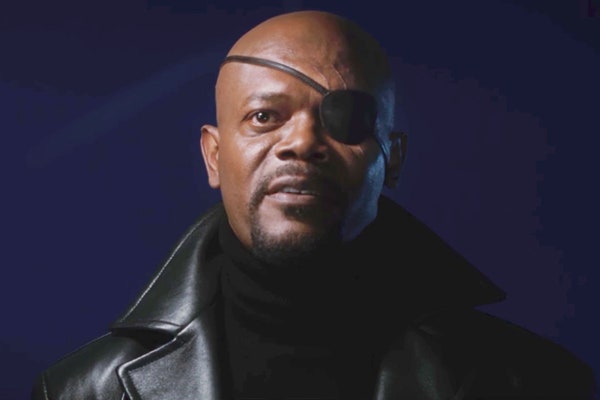
The first film in Kevin Feige’s role as head of production for Marvel Studios didn’t invent the post-credits sequence. But it turned it into a hallowed ritual, an extra, even more niche bit of fan service than what the main feature has just offered up. The first one came with Iron Man, in which snappy Robert Downey Jr., playing Tony Stark, meets Nick Fury (Samuel L. Jackson), who intimates that a whole Avengers team may someday be assembled. Of course, said team was put together, and now everyone stays for at least the mid-credits bit after all of these movies—whether they’re from Marvel or not. Fans who get the references hoot with knowing satisfaction, while the uninitiated experience a reluctant tingle of curiosity that something even grander may be on its way. Most post-credits scenes are totally unnecessary, but they are nonetheless tradition now, because we have given so much of the world to the geeks that we’ll now sit as the names of thousands of strangers roll by, just to see a little more. —R.L.

“I was there maybe an hour and a half, because I think at that time, I had my own mustache and goatee. Having been a comic-book fan my whole life, and knowing who Nick Fury was and the history of it, to go into a comic-book store and see myself on a comic book was like, ‘Wait a minute. This is awesome.’ And if that had been what it was, that would have been fine. But actually, it bred a real presence beyond anything I could have imagined. It’s been a real joy to be able to hang out with all of these superheroes and find out who they are, find out how Nick Fury fits in their world, without having a particular superpower—other than being very persuasive. It’s pure joy. Doing Iron Man was the initial step for me to [get to] a space of, ‘O.K., how do I want to present him? Is he cool? Is he rough? Is he harsh? Is he humane?’ Finding that sweet spot that’s going to make people care about how he is, and want him to be a part of that universe.” —As told to Julie Miller
“The Hero Gotham Deserves”The Dark Knight(2008)
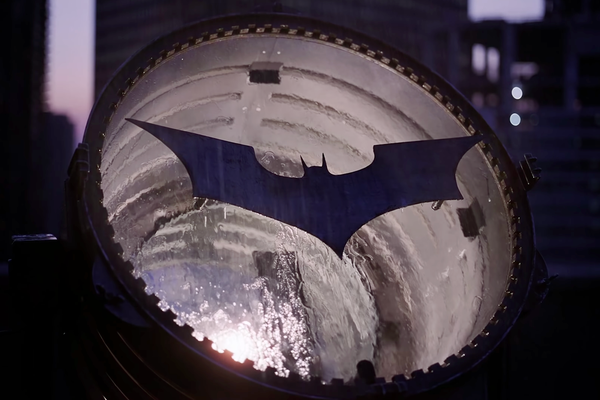
The history of the American blockbuster, and the superhero movie specifically, has played out in phases. If Tim Burton’s 1989 Batman was the beginning of one, ushering in a new, long era of mainstream U.S. action movies, then Christopher Nolan’s The Dark Knight was the beginning of another: it marked the point when the genre grew up—or tried to.
The history of the superhero movie is still, by and large, a conflict between the well-oiled Marvel aesthetic and the broodier DC mood, which has had fits and starts, and which obviously tried to take a cue from Nolan’s book. The Dark Knight was no Tim Burton Batman, nor was it the comparatively airy and kid-friendly confines of Sam Raimi’s Spider-Man films. Nolan’s movie had more in common with Michael Mann than with the world of Adam West; his Joker, a live scorcher on-screen played by Heath Ledger, was more unpredictable anarchist than rote movie villain. The action set pieces and script had more heft; the style was harder, toned down. Commissioner Gordon’s closing salvo about “the hero Gotham deserves” would sum all of that up mightily, giving the Batman universe—and superhero movies, with it—a dramatic maturity, a rock-steady sense of mythology, that the genre to that point lacked. This isn’t just a superhero movie. That speech says: this is the film made to convince us that they will last. —K.A.C.

“I told Chris the music was too loud—you couldn’t hear the lines. He said, ‘I wrote them. I can do what I want.’ He was right; people do remember the lines. He could have done 200 different cop-out endings, but he put that ending on. It’s hard to pull off a satisfying ending, if you’re that ambiguous. One second longer, or one sentence or note different, and it would have been a different movie. When Heath Ledger was cast, there was an outcry from an audience, forgetting that it’s not for us to ask what they want to see—it’s for us to make something they can’t even imagine. It’s a Batman movie, but not what you imagine a Batman movie to be. And it surprised everyone. Isn’t that what you’re supposed to do?” —As told to Joanna Robinson
When Edward Met BellaTwilight(2008)
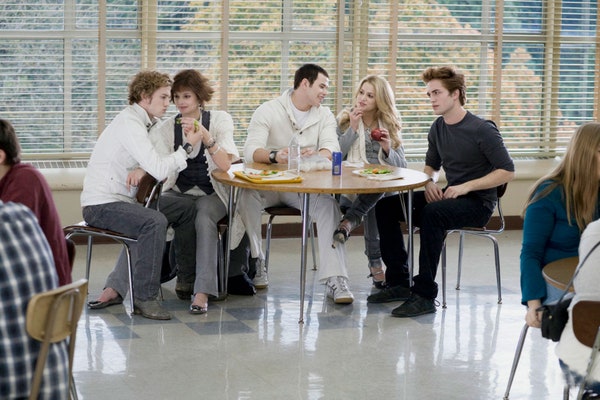
With one longing and curious look across a high-school cafeteria—human Bella (Kristen Stewart) clocking vampire Edward (Robert Pattinson)—the Y.A. boom was crystallized. It may have been a short-lived craze, peaking with the The Hunger Games and sputtering out with the Divergent series. But in that brief time, Twilight fever reshaped our understanding of youth culture, and turned the industry’s gaze toward fan corners of the Internet, in search of the emo heart that gave life to a generation. It shouldn’t go without mentioning that the majority of those fans were young women, whose ardency and buying power could not be denied. We can thank this scene for Fifty Shades of Grey, though its effect may be better felt on television these days, where appealing to fandom is vital to many networks’ strategies. Twilight also launched Stewart and Pattinson to stardom, though both have since shaken off the teen-idol trappings and become bold indie-film explorers. —R.L.

“We all knew that Rob and Kristen were more indie spirits in a way, because [of] the way they dressed, what they read, what music they listened to, what movies they liked. They weren’t just super-big, popular-movie type people. I guess the fact that they did not know this was going to be this big, crazy, mainstream juggernaut—they knew me a little bit from Thirteen and Lords of Dogtown. They knew I would have that sensibility. If Twilight was known to be a blockbuster, it wouldn’t be a female director. I think they trusted me, exploring this first love, but nobody thought it would turn into this crazy-worldwide-blockbuster insanity. The good thing is that it gave them enough worldwide cred and clout that they could green-light all these super-interesting films later in their careers. I think it’s an amazing ripple effect.” —As told to Katey Rich
The Favela Chase
Fast Five(2011)
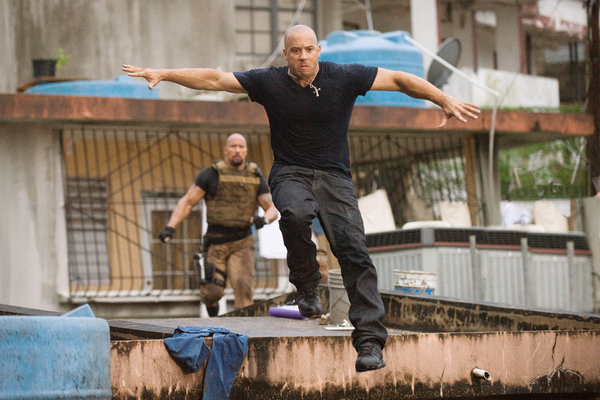
Fast Five is best thought of as a point of transition. Set entirely in Rio de Janeiro, this is the movie that brought the series into its second phase of familial sentimentality and go-for-broke action set pieces. And, perhaps more important, it’s the movie in the series that introduces Luke Hobbs, played by Vin Diesel’s ideal action foil: Dwayne Johnson, who is now, thanks in no small part to the Fast series, one of the biggest action stars in the country. The movie is full of classic set pieces and the vigorous mix of humor and action that would come to define the rest of the franchise, as would its remarkably diverse cast and roster of directors. But the favela chase, pitter-pattering across the hot, slippery rooftops of a poor Rio neighborhood, effectively sums up the movie’s role in the broader franchise, becoming something new while remaining true to what it is. —K.A.C.

“I remember Adam Fogelson, who was running the studio at the time, and Donna Langley, they were really kind of excited about going bigger and bigger. Their mantra was you guys don’t have capes, but we’re the proletariat superheroes. We need to start delivering that. The foundation of the family and brotherhood are so strong, now what we have to do is focus on the spectacle and kind of one-upping each film in terms of the spectacle and wish fulfillment and enjoyment of watching the scenes. I remember when we were in the favelas in Rio, the police were saying, ‘You guys are safer than the police.’ Everyone would open up their doors and they would offer whatever they had. We were for the people, we were representing the people. We were saying despite where you come from you can be empowered, you can be effective, you can have your own code and you can be honorable. That’s something I remember like yesterday.” —As told to Katey Rich
The Sunken PlaceGet Out(2017)
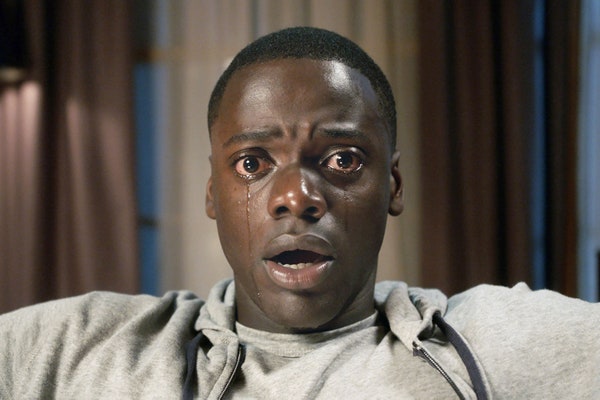
There’d been horror films about race before (Candyman and The People Under the Stairs both come to mind), but none distilled and furthered the American conversation about race, or (re)introduced socially conscious horror with quite as lively a style or contagious a concept, the way Get Out does. Jordan Peele’s 2017 fire-starter was a mega-hit that proved, like Hidden Figures before it and Black Panther after, there was an untapped black audience currently being underserved by Hollywood.
And the concept—a sly merging of the classic American race drama Guess Who’s Coming to Dinner with the plastic horror of The Stepford Wives—managed to spur an unanticipated rush of memes and references online and throughout the culture. Nothing traveled further or enriched the culture more vividly than “the sunken place,” and the scene of the sunken place itself, a slow-motion vacuum of racialized horror shot through with a bolt of light that sets Daniel Kaluuya’s screaming face ablaze with existential meaning. The idea of the sunken place on its own is good, but it wouldn’t be nearly as effective without the sleek, wondrous design of this scene, which perfectly performs the black terror at the heart of Peele’s movie. With any luck, the history of American movies will never recover from this knockout punch. —K.A.C.

“I always had this concept of the place that you’re falling toward when you’re going to sleep, and you get that falling sensation and catch yourself. And if you didn’t catch yourself, where would you end up? I had this hellish image, and I thought of this idea of, ‘What if you were in a place, and you could look through your own eyes as if they were literal windows or a screen, and see what your body was seeing, but feel like a prisoner in your own mind—the chamber of your mind?’ The moment I thought of that, it immediately occurred to me the theme of abduction and connection to the prison industrial complex that this movie was sort of presenting a metaphor for. It was a very emotional discovery. I remember having so much fun writing it, but at that moment when I figured out this weird, esoteric, but also emotionally brutal form of suffering to put the character through—I literally cried writing the scene.” —As told to Julie Miller
Photo Credits
By Miikka Skaffari (Docter), Jon Kopaloff (Barrymore), by Paul Archuleta (Apatow), by Jason LaVeris (Diesel), all from Filmagic; by Steve Granitz (Nucci, Jackson), by Gary Gershoff (Reaves), by Mark Sagliocco (Lee), by Gary Gershoff (Serkis), by JB Lacroix (Myers), all from WireImage; by Kevork Djansezian/NBC (Bridges), by VALERIE MACON/AFP (Hanks), by Scott Gries (Myrick), by George Pimentel (Harron), by Michael Loccisano (Fuqua), by Paul Morigi (Moore), by Jared Siskin/Patrick McMullan (Coppola), by ANTHONY HARVEY/AFP (McGregor), by Stephane Cardinale/Corbis (Chivo), by Lars Niki (Tichenor), by Alberto E. Rodriguez (Hardwicke), by FREDERIC J. BROWN/AFP (Peele), all from Getty Images. By Jim Smeal/REX/Shutterstock (Wilson).